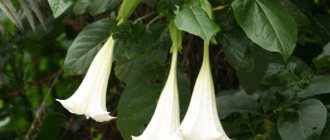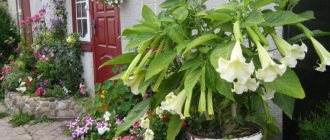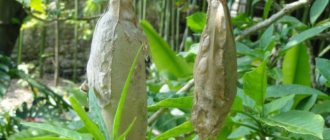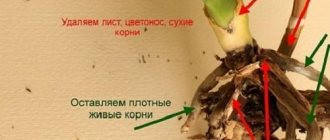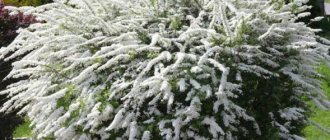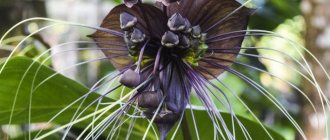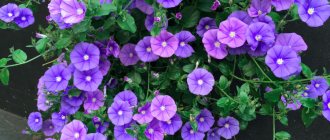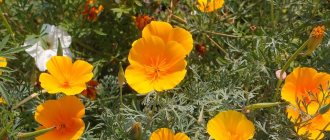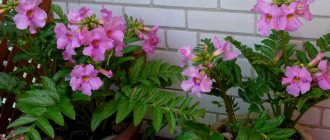In recent years, a beautiful plant, Brugmansia, has become popular. This is an original terrace flower that can be transplanted into open ground in summer. Its funnel-shaped flowers reach a length of 30 cm and smell wonderful. In summer, during one flowering period, it can produce several dozen flowers. In this article we will tell you how to grow Brugmansia - planting and care in the open ground and at home, how to ensure wintering, spring awakening, and provide a description of the varieties with photos.
Lighting
This is a light-loving plant that requires bright sunlight all year round.
Direct sunlight does not harm it; on the contrary, Brugmansia needs direct sun for several hours every day .
In winter, when there is not enough light and daylight hours decrease, the plant can stretch out and lose its decorative appearance. Therefore, it must be illuminated with electric lamps or the temperature of the contents reduced so that it does not grow.
Types and varieties. Photo
The genus Brugmansia belongs to the nightshade family and has few natural varieties. It’s worth getting acquainted with them, you will find out how they can winter in Russia, under extreme conditions for the plant.
Firstly, it should be warned that the shrub can only survive the winter indoors. The best option is a greenhouse, or an insulated veranda, where the air temperature does not drop below +10°C. Alternatively, you can grow the plant as an annual shrub through seedlings.
Meet them:
- B.aurea.
- B. suaveolens.
- B. sanguinea.
- B. versicolor.
- B. arborea.
- B. vulcanicola.
The plant also has varieties with double flowers. Brugmansia flowers are arranged with the gramophones downwards, do not confuse them with Datura, they grow upwards.
Unfortunately, there are few suitable varieties for cultivation in Russia. The spread of this magnificent plant is hampered by sub-zero temperatures throughout almost the entire country. The permissible temperature at which the plant can exist is not lower than +5-+8°C, just below this mark on the thermometer, the green mass of Brugmansia dies.
The soil
Brugmansia does not tolerate very acidic soil. The proportion of peat in the soil mixture for Brugmansia should be no more than 50% .
You can purchase soil for it at a flower shop: universal soil for flowering plants with or without the addition of peat is suitable.
If you prepare the soil yourself, the best composition will be a mixture of peat, humus and turf soil in equal parts. It is advisable to add sand or perlite here for greater looseness.
Before planting a flower, it is advisable to disinfect the soil by watering it with a weak solution of potassium permanganate.
How to plant Brugmansia in open ground
Despite the fact that the plant is characterized by increased heat-loving behavior, in the summer it is usually planted in open ground, even in the middle zone. In order for planting and caring for the Brugmansia garden flower to be successful, you need to know the basic rules.
When to plant Brugmansia in open ground
In the garden, a tropical flower is planted only in late spring, when the last frosts have passed and the plant is no longer threatened by cold snaps. For the middle zone, planting is recommended at the end of May or beginning of June; during this period there is no need to worry about the successful rooting of the flower.
Preparation of planting material
A sensitive flower must be prepared for planting on the site. Preparation consists of gradual hardening of the plant.
Since outdoor conditions are very different from indoor conditions, several weeks before planting the plant should be taken out into the fresh air for several hours every day. Each time, the time spent outside is gradually increased up to a whole day, thanks to this the flower easily acclimatizes to new conditions and quickly takes root in the soil.
Soil for Brugmansia
The plant loves light but fertile soils. The ideal soil for a flower is loam with the addition of peat and compost or humus in a 1:2:1 ratio. It is also necessary to provide good drainage in the soil so that moisture does not stagnate at the roots of the plant.
Brugmansia prefers well-lit places on the site. At the same time, the place for planting the plant should be well protected from drafts - the stems of the flower are long and fragile, and they can break in a strong wind.
Advice! To avoid breaking the stems, Brugmansia can be secured to supporting supports.
Brugmansia planting rules
Before planting a flower in the ground, it is necessary to prepare the soil - add a little peat and humus to it, and apply complex fertilizers.
- The hole for planting the plant must correspond to the size of the roots of the seedling and in depth exceed their length by about 15 cm.
- It is necessary to pour a drainage layer at the bottom of the planting hole; it will make caring for the plant easier, as it will prevent stagnation of water in the area.
- The prepared hole is filled with soil mixed with humus and peat to the middle, and then the Brugmansia is lowered into the hole and filled with soil until the end.
- Immediately after planting, the plant must be watered, lightly compacted the soil and sprinkled with a layer of dry soil. You can also mulch the flower with sawdust or straw - mulch will help prevent premature evaporation of water.
In the photo of planting and caring for Brugmansia flowers, you can see that when planting it is important to monitor the position of the root collar of the plant. It should be at the same level as in the container where the seedling grew before.
Fertilizer
The plant needs to be fertilized only during the period of growth and flowering in spring and summer. Complex mineral fertilizers for deciduous plants are suitable for feeding before flowering. Feeding is carried out 2 times a month, starting in April.
After the buds appear, Brugmansia is fed with fertilizers for flowering plants. They are introduced into moist soil a few hours after watering.
After Brugmansia finishes flowering, feeding is gradually stopped.
It is recommended to feed Brugmansia with organic fertilizers 1-2 times a season.
Suitable for this purpose: diluted chicken manure, mullein, or purchased organic fertilizers for indoor and garden plants.
Peculiarities
In summer, the plant feels best outdoors. It is advisable to take it out into the garden, onto the terrace or onto the open balcony during the entire warm period.
In winter, Brugmansia requires a cool hibernation . As the air temperature drops, the growing season decreases more and more. Therefore, the lower the temperature of the plant, the weaker the lighting can be.
If the plant is kept at a temperature of about 8-9ºС, it does not need bright light, since in such conditions it does not grow or stretch. If it overwinters at a higher temperature, it needs good lighting.
All parts of Brugmansia are poisonous. Brugmansia should not be placed in children's rooms or in places where pets can reach. It is advisable to carry out all work with it wearing protective gloves.
We reveal the secrets of caring for Brugmansia
- VK
- Youtube
Do you look with admiration and envy at the Brugmansia blooming profusely in your neighbor’s garden? So, this tub plant blooms throughout the summer with a lush fountain of huge, slightly drooping tubular-bell-shaped flowers of divine shades, but in order to achieve such excellent flowering, you need to know and skillfully apply some very useful tricks.
Flower pots and soil
In a pot that is too small, Brugmansia suffers from drying out soil, as its drooping leaves will tell you. Young plants should be replanted every spring into a new pot with a diameter 2-3 cm larger than the previous one. For this tree-like shrub, which is also called angel trumpets, plastic pots are best suited rather than clay or terracotta: because the root system in them grows more evenly, and thin roots do not grow to the walls. It is very important to make drainage holes in the bottom of the container through which excess water escapes.
The large leaves of Brugmansia evaporate a lot of moisture, and when there are gusts of wind, they lose their balance and can easily break off. Therefore, it is worth choosing a large enough tub for the plant that can hold more water and be quite stable. Large stone tubs are highly prized. On the bottom, in which holes are made to drain excess water, pour a layer of expanded clay. When growing Brugmansia, use regular soil for tub plants. The further development of the plant is very favorably affected by the addition of some clay granules to the soil, which conserves moisture and nutrients. If in doubt, enrich the substrate with clay granules or expanded clay at the rate of 10% of its total volume.
Brugmansia 'Feuerwerk' (Brugmansia sanguinea) in a tub made of plastic imitating the texture of stone casting
Tip: in summer Brugmansia should be planted directly in open ground in the garden. This way, your flowering shrub will be more evenly supplied with water. However, before the first frost, the cold-sensitive plant must be carefully dug up and planted in a tub, placing it in a place protected from frost for the winter. Digging up the roots every year does not harm the plant.
Ideal location
In spring, Brugmansia should be left in a slightly shady place for some time (3-4 days) so that it can get used to intense sunlight. Our angel trumpets will then be able to withstand even direct sunlight. A sheltered from the wind, very bright, but shaded from the midday sun place in the garden or on the terrace is ideal. Diffused shade for the plant is created, for example, by tree crowns or lace umbrellas.
Abundant watering
Brugmansia, with its large, oval-elongated, slightly pubescent leaves, consumes an extremely large amount of water. Therefore, in summer it is necessary to water the plant at least once, and on hot days - even twice a day. Water until excess water comes out of the drainage holes and into the pan.
Fragrant Brugmansia 'Frosty Pink' (Brugmansia suaveolens). In nature in its homeland, in southeastern Brazil, it reaches up to 5 m in height
Generous feeding
Brugmansia, like almost all members of the nightshade family (Solanaceae, which includes, for example, tomatoes and tobacco) is a strong consumer of nutrients. And the key to their long and abundant flowering is regular and generous feeding. Therefore, already in the spring, during replanting, long-acting fertilizer should be mixed into fresh soil for balcony or tub plants. In addition, from May to August, feed your beauty once or twice a week with liquid fertilizer for flowering plants, adding it to the water for watering. And you can be completely calm, in the case of Brugmansia, oversaturation with fertilizers is almost impossible! The experience of many amateur gardeners shows that good results can be achieved with the help of conventional mineral fertilizer, for example Blaukorn. Dissolve two heaped tablespoons in 10 liters of water for irrigation. At the end of August, all feeding should be stopped, which will stop the growth of the plant and contribute to the lignification of the shoots.
Garden bench framed by abundantly flowering Brugmansia bushes
Pruning: pay attention to the shape of the leaves
During the period when Brugmansia is in the open air, it, in principle, does not need pruning, since the plant branches well and forms a sufficient number of flower shoots. In the winter apartment, our angel trumpets, due to lack of light, send out mostly thin, few-branched shoots with small, pale green leaves. Such shoots should be shortened in the spring, leaving only 1-2 asymmetrical leaves. The plant produces flowers above Y-shaped branches called “forks.” The flowering zone can be determined by the base of the leaf: a symmetrical leaf indicates the growing zone, and a ledge at the base of the leaf indicates the beginning of the flowering zone. In the fall, Brugmansia is pruned so that it does not take up too much space in the winter apartment. Attention: trim the plant so that at least one asymmetrical leaf remains on one flower shoot. Trimming shoots to leave only symmetrical leaves will delay flowering next season.
Advice: after pruning, in the fall, do not immediately transfer the plant indoors for wintering. Leave the cut brugmansia for several days on a warm terrace to allow the fresh cuts to dry.
The flowering areas of the shoots have asymmetrical leaves (leaf on the left). In the zone with symmetrical leaves, that is, leaves of the correct shape (leaf on the right), flowers do not form. When pruning a plant, you should not leave only symmetrical leaves.
Common diseases and pests
Brugmansia is almost not susceptible to diseases, but can be affected by various pests, for example, weevils. Beetles can be very easily recognized by their characteristic, semicircular, eaten away areas along the edges of the foliage. Snails also love to eat soft, fleshy leaves. In addition, Brugmansia is often affected by spider mites. As a rule, plants that are kept in poorly ventilated areas all year round suffer from it.
Wintering
Brugmansia is left to overwinter in a bright, cool (about 10-15°C) room. This could be a winter garden. In such conditions, the plant completely retains its leaves and continues to bloom for some time - which is not given to everyone due to flowers that have an intense aroma. Some gardeners place Brugmansia in a dark place for the winter. In any case, the air temperature should be, if possible, stable around 5° C. In such conditions, the plant sheds almost all its leaves, but recovers very quickly in the spring. In a dark, cold room, brugmansia is watered so that the roots do not dry out. If the plant overwinters in a bright room, then it should be watered more and checked for pest damage more often.
Several amazing Brugmansia varieties from the private garden of Monika Gottschalk, Germany
| Abundantly blooming Brugmansia (Brugmansia x cubensi)s 'Edna' with bell-shaped, drooping, double flowers of medium size (27 - 29cm), painted in a delicate white-pink color. | The charming Brugmansia (Brugmansia x cubensis) 'Fandango' amazes with its bell-shaped, white flowers with a peachy bloom. To prolong abundant flowering, Brugancia should be in partial shade in a place protected from the winds. |
| Brugmansia x candida 'Marie Stöppler' with large (30 – 33 cm), drooping, double bell-shaped flowers of soft pink color. | Snow-white Brugmansia "Brugmansia x candida" 'Diebsteinperle' with double, drooping bells (30 - 33cm) of a peculiar shape. Abundantly flowering hybrid. |
Large (30 – 33cm), very beautiful drooping flowers with a wide corolla of Brugmansia x candida 'Luise'. The color of the flowers is cream with an apricot bloom.
Translation: Lesya Vasko especially for the gardening internet portal
Publication date: July 22, 2010
comments
Lesya Vasko
If you notice an error, select the required text and press Ctrl+Enter to report it to the editors
Comments:
There are no comments yet, you can add your own comment. For this you need to register or log in.
Authorization
You have entered an incorrect login/password
adding a comment
Useful articles
- Studio LoraShen
Diseases
The most common disease of Brugmansia is gray rot, which affects leaves, shoots and trunk. Also, sometimes the plant suffers from root rot. These diseases appear only when the plant is not watered correctly, when water stagnates in the soil or in the internodes of the branches. It should be remembered that excessive moisture can destroy the plant.
If fungal infections have not spread throughout the plant, you can trim the diseased branches to healthy tissue, and collect and destroy the rotten parts. In case of root rot, the plant is kept without watering for about a week so that the soil dries out, and then they begin to water very moderately.
Brugmansia can be parasitized by many pests: spider mites, whiteflies, thrips, aphids, caterpillars and slugs. Slugs must be collected by hand.
Insecticidal preparations that need to be sprayed generously on the plant will help against other pests. If necessary, the treatment is repeated after a week.
Forums and reviews
On one of the forums, its participants are concerned about why Brugmansia has no seeds. Forum member Marusya believes that the flower simply has not yet reached the time to form seeds.
Another question is whether it is worth sending the plant into hibernation. Last year the bush overwintered poorly, I had to re-root it in the summer, so I don’t know whether to force it to bloom or send it into hibernation, although the leaves are green and are not going to fall off. Please advise!
And I’m concerned about the size of the plant, what can be done so that Brugmansia doesn’t take up so much space in the room. Safi has not yet answered this question.
Brugmansia is a beautiful plant and not so difficult to care for. Of course, in our northern country, it is better to grow it as a potted plant. Don’t be afraid of caring for Brugmansia at home, you’ll see that it will thank you for your care with gorgeous blooms.
Problems
This plant is considered unpretentious, however, it can suddenly become ill and die. Problems arise when growing Brugmansia even among experienced gardeners. Most often, it is not possible to achieve flowering of the plant, or the buds that appear begin to fall off.
Brugmansia usually does not bloom due to insufficient lighting . At the same time, its shoots weaken and become thinner. Flowering can also be affected by lack of nutrients.
To get a flowering tree, it needs to be regularly fed and replanted in new soil.
Buds fall off for several reasons. They may suddenly fall off due to a sharp drop in air temperature. They also fall off if the plant lacks moisture.
You cannot move Brugmansia with buds to another place: due to changes in lighting, it may drop the buds.
Description of the plant
Novice gardeners sometimes confuse Brugmansia with Datura (Datura). Brugmansia was isolated from the Datura genus. Therefore, it’s worth first understanding the similarities and differences between Brugmansia and Datura. Datura (lat. Datura) and Brugmansia belong to the Solanaceae family.
Do not allow children to play with them, because in all species of Brugmansia and Datura, all parts of the plants are very poisonous. Consuming a few Datura seeds can result in death.
Datura is an annual herbaceous plant 0.5-1 m high, rarely tree-like. The stem is bare and erect. The leaves are dark green (the leaf blade is lighter at the bottom), alternate, reach a length of 10-15 cm, located on long petioles, ovate, with a pointed tip, light veins. Datura flowers are large, white, shaped like a funnel, the flower calyx is five-toothed. The fruit is a four-leaf capsule with thorns.
The genus Brugmansia includes trees (1.5-6 meters high, depending on the species) and subshrubs. The plant originates from South America, more precisely from the Andes regions stretching from Colombia to northern Chile and southeastern Brazil. Introduced and spread to Africa, Asia and Australia. Their popularity is due to flowers of unusual size, in the form of giant bells or so-called “tubes”. Hence the common name of Brugmansia – “angel’s trumpets”. There are hundreds of varieties in cultivation in various palettes of white, cream, yellow, orange, pink, purple and red, with single, double and even triple and quadruple flowers. The leaves and flowers are large.
Brugmansias are evergreens. When grown in temperate climates, their vegetation is largely suppressed in winter. This does not greatly affect viability as long as there are no sub-zero temperatures.
Reproduction
Brugmansia is propagated by seeds and vegetatively. Growing from seeds is not a very popular propagation method, as it is a labor-intensive and time-consuming process, and a flowering plant can only be obtained after 3 years.
Seeds are sown in containers with moistened soil, covered with film and kept at a temperature not lower than 22ºC for at least 1.5 months. Over time, the sprouts dive into separate pots.
Vegetative propagation method is the most common . Cuttings are harvested in the spring during annual pruning. They are rooted in water or soil.
When rooting in water, they are placed in boiled water until roots form, and then planted in separate pots with soil.
When rooting in the ground, the cuttings are buried in pots with perlite or sand and covered with glass jars. Usually, 100% of the cuttings take root.
What to do if Brugmansia leaves turn yellow and fall off
The main reason for the yellowing of the leaves of this plant is acclimatization. This is a completely normal phenomenon after transplantation or after the flower pot has been taken out of the room. The condition of the flower will be restored over time.
Another very common cause of yellowing and falling leaves is poor soil. In depleted soil, the bush feels very bad, and in this case it needs to be fed.
Brugmansia can also respond by dropping leaves to a lack of light and too dry air.
Transfer
This large plant needs to be replanted every year or even twice a year in the first 2-3 years of its life. Its root system grows quickly, so the flower is transplanted by transferring it into a larger pot. Transplantation can be carried out in the spring before the beginning of the growing season and in the fall before the start of wintering.
Adult Brugmansias after 3 years of age are replanted every 2 years.
A thick drainage layer is placed at the bottom of the pot so that water does not stagnate in the soil. Transplantation is carried out using the transshipment method.
Do not replant very large and old plants growing in tubs that, due to their size, cannot be removed from the pot. In this case, the top layer of soil in the tubs is replaced with fresh fertile soil twice a year.
Basics of culture
When the temperature drops below +10°C and harvesting for “wintering”, it is recommended to trim the ends of the branches. But it’s worth remembering in the spring, when the plant begins to grow and will give you a lot of cuttings, and don’t forget that deep pruning can shorten the “flowering zone” of next year. Flowers (“flowering zone”) are formed in Brugmansia at the “forks” of the branches. How else can we accurately determine this zone? There are indications in foreign literature that the “flowering zone” has leaves that are asymmetrical at the base.
So, the main advice for pruning is not to remove the “forks” of branches, since it is on them that flowers form, to pay attention when pruning in autumn and not to remove shoots with asymmetrical leaves. So remember the “golden mean” in this matter.
Brugmansia goes to winter. Photo from gardeningknowhow.com
The substrate for Brugmansias is recommended to be slightly acidic, and fertilizing is recommended throughout the entire growth period. Many gardeners send Brugmansias for the winter in other containers - old buckets, boxes, even thick bags, and the container for Brugmansias is slightly frozen. Obviously, this is useful for combating diseases and pests that can “attack” the plant and accumulate in the substrate over the season.
My personal problem with Brugmansia is spider mites and high wintering temperatures in the apartment. So the fate of my Brugmansias is to grow up on the balcony and go into the “good hands” of friends with a private house and a plot with it. It’s easier for me to then ask for a cutting or buy a new variety from my own hands.
This year, for the first time, I saw a whole garden of Brugmansias planted directly into the ground. They looked great, but spent the winter in a greenhouse. If you have such an opportunity, try it! When planting directly into the ground, you can avoid some problems, for example, overflow and rot, or cramped containers. In addition, the plant can reach its full size in the ground, which is often impossible when grown in a pot.
